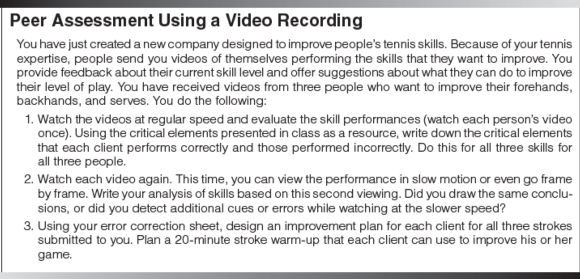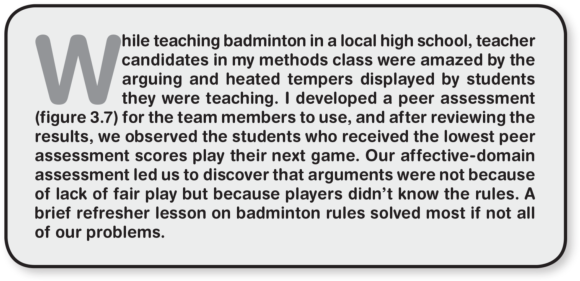Assessing Student Learning Through Projects
This is an excerpt from Performance-Based Assessment for Middle and High School Physical Education-3rd Edition by Jacalyn Lea Lund,Mary Fortman Kirk.
Projects
Projects are excellent ways to assess student learning in physical education. The tennis assessment found in figure 3.8 assesses student knowledge of the skills used to play tennis. By assessing students' accuracy for their use of cues on their assessments, teachers determine students' knowledge of the critical elements and their ability to apply that knowledge. Since the same video is used for all members of the class, teachers can assess students' ability to distinguish between correct and incorrect performance. Results of this assessment document student cognitive domain learning. If the video clips are loaded onto a computer and uploaded to a website, students complete the assessment as homework either at home or in a school computer facility.

Figure 3.8 An example of peer evaluation using a video recording.
Magazine Project
This magazine project assesses students' knowledge in a meaningful way. For the project, each member of the group is responsible for some type of editing (e.g., features, cover, artwork, advertising), and every student in the group contributes an article and an advertisement, which must address something healthy and make use of information learned in class. If, for example, the magazine's content addresses activity settings available in the community, students are assessed on some elements of SHAPE America Standard 3. Students choose a title for the magazine, and all articles must reflect the title or overall theme. Teachers often find that students produce creative results, especially given the computer skills of today's students. Students are required to reflect on their input into the magazine and on what they learned by doing the publication.
Weightlifting Assessment
A teacher candidate used digital photography to develop a weightlifting project assessment in response to students making errors on the lifts (e.g., not using correct form) and not knowing the names of the lifts. For this project, students took a series of pictures that named the lift and demonstrated proper technique for the station. The pictures were used for posters and put at each of the lifting stations. The next part of the project required students to analyze members of the group for correct form on their assigned lift and diagnose errors. The final part of this project involved students setting goals for their station and developing a plan for meeting them. Student reflections were rich with what students had learned. Completing the project was a meaningful learning experience as documented by their portfolios.

The Playbook and Reflection
A final example of a project to evaluate cognitive learning in physical education was the creation of a playbook for a soccer unit. Students were required to use invasion tactics and develop plays that utilized their strengths as a team. Prior to playing another team, students scouted the competition and analyzed the other team's strengths and areas of weakness. Using the analysis of their strengths, they devised a plan for defeating the other team during play. A post-game reflection helped team members determine whether their strategy was successful. The team logged scouting reports (see figure 3.9) and game reflections throughout the unit and did a final reflection about their growth and success as a team.
More Excerpts From Performance-Based Assessment for Middle and High School Physical Education-3rd EditionSHOP

Get the latest insights with regular newsletters, plus periodic product information and special insider offers.
JOIN NOW


